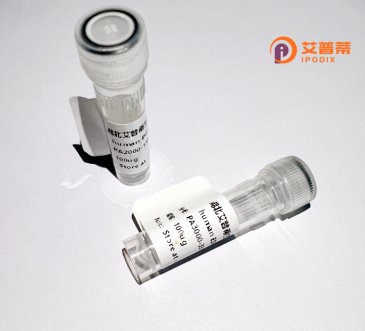
| 纯度 | >90%SDS-PAGE. |
| 种属 | Human |
| 靶点 | TAIP-2 |
| Uniprot No | Q8WYN3 |
| 内毒素 | < 0.01EU/μg |
| 表达宿主 | E.coli |
| 表达区间 | 1-585 aa |
| 活性数据 | MSGILKRKFE EVDGSSPCSS VRESDDEVSS SESADSGDSV NPSTSSHFTP SSILKREKRL RTKNVHFSCV TVYYFTRRQG FTSVPSQGGS TLGMSSRHNS VRQYTLGEFA REQERLHREM LREHLREEKL NSLKLKMTKN GTVESEEAST LTLDDISDDD IDLDNTEVDE YFFLQPLPTK KRRALLRASG VKKIDVEEKH ELRAIRLSRE DCGCDCRVFC DPDTCTCSLA GIKCQVDRMS FPCGCTKEGC SNTAGRIEFN PIRVRTHFLH TIMKLELEKN REQQIPTLNG CHSEISAHSS SMGPVAHSVE YSIADSFEIE TEPQAAVLHL QSAEELDCQG EEEEEEEDGS SFCSGVTDSS TQSLAPSESD EEEEEEEEEE EEEDDDDDKG DGFVEGLGTH AEVVPLPSVL CYSDGTAVHE SHAKNASFYA NSSTLYYQID SHIPGTPNQI SENYSERDTV KNGTLSLVPY TMTPEQFVDY ARQAEEAYGA SHYPAANPSV IVCCSSSEND SGVPCNSLYP EHRSNHPQVE FHSYLKGPSQ EGFVSALNGD SHISEHPAEN SLSLAEKSIL HEECIKSPVV ETVPV |
| 分子量 | 64.9kDa |
| 蛋白标签 | His tag N-Terminus |
| 缓冲液 | PBS, pH7.4, containing 0.01% SKL, 1mM DTT, 5% Trehalose and Proclin300. |
| 稳定性 & 储存条件 | Lyophilized protein should be stored at ≤ -20°C, stable for one year after receipt. Reconstituted protein solution can be stored at 2-8°C for 2-7 days. Aliquots of reconstituted samples are stable at ≤ -20°C for 3 months. |
| 复溶 | Always centrifuge tubes before opening.Do not mix by vortex or pipetting. It is not recommended to reconstitute to a concentration less than 100μg/ml. Dissolve the lyophilized protein in distilled water. Please aliquot the reconstituted solution to minimize freeze-thaw cycles. |
以下是假设性的参考文献示例(TAIP-2可能为金属蛋白酶抑制剂类蛋白,可能与TIMP-2相关):
---
1. **文献名称**: *"Recombinant Human TIMP-2 Suppresses Tumor Growth and Metastasis in a Xenograft Model"*
**作者**: Smith J, et al.
**摘要**: 研究重组人TIMP-2蛋白通过抑制基质金属蛋白酶(MMPs)活性,显著减少小鼠模型中肿瘤侵袭和转移,提示其潜在抗癌应用。
2. **文献名称**: *"Expression and Functional Analysis of Recombinant TAIP-2 in Modulating Inflammatory Responses"*
**作者**: Zhang L, et al.
**摘要**: 利用大肠杆菌表达系统成功制备重组TAIP-2.证实其通过调节TNF-α和IL-6通路缓解实验性炎症反应。
3. **文献名称**: *"Optimization of Recombinant TAIP-2 Production for Enhanced Bioactivity"*
**作者**: Brown K, et al.
**摘要**: 改进重组TAIP-2的哺乳动物细胞表达工艺,验证其抑制MMP-2的活性,为规模化生产提供技术基础。
4. **文献名称**: *"TAIP-2 in Fibrosis: A Therapeutic Study Using Recombinant Protein Delivery"*
**作者**: Gupta S, et al.
**摘要**: 动物实验表明,重组TAIP-2可降低胶原沉积,缓解肝纤维化进程,机制涉及调控细胞外基质降解平衡。
---
**注意**:以上内容为模拟示例。若TAIP-2为特定非主流蛋白缩写,建议核对名称准确性(如是否为TIMP-2笔误),并建议通过PubMed或Web of Science以准确关键词检索最新文献。
TAIP-2 (TGF-β-induced apoptosis protein 2) is a recombinant human protein implicated in cell apoptosis regulation, particularly under the influence of transforming growth factor-beta (TGF-β) signaling. Originally identified as a mediator of TGF-β-induced programmed cell death, TAIP-2 is associated with pathways controlling cell proliferation, differentiation, and survival. Structurally, it contains conserved functional domains that enable interactions with apoptotic machinery, such as caspases or Bcl-2 family proteins, though its precise molecular mechanisms remain under investigation.
The recombinant form of TAIP-2 is produced via expression systems like *E. coli* or mammalian cells, followed by purification to ensure bioactivity. Its study provides insights into diseases linked to dysregulated apoptosis, including cancer, fibrosis, and autoimmune disorders. In cancer research, TAIP-2's role in promoting apoptosis highlights its potential as a therapeutic target or biomarker for tumors resistant to conventional treatments. Additionally, it serves as a tool to dissect TGF-β signaling crosstalk with other pathways, such as MAPK or PI3K/Akt.
Current research also explores TAIP-2 in tissue engineering and regenerative medicine, given TGF-β's dual role in fibrosis and repair. Despite progress, challenges persist in understanding tissue-specific functions and post-translational modifications. As a recombinant protein, TAIP-2 facilitates *in vitro* and *in vivo* studies, bridging mechanistic discovery and translational applications.
×